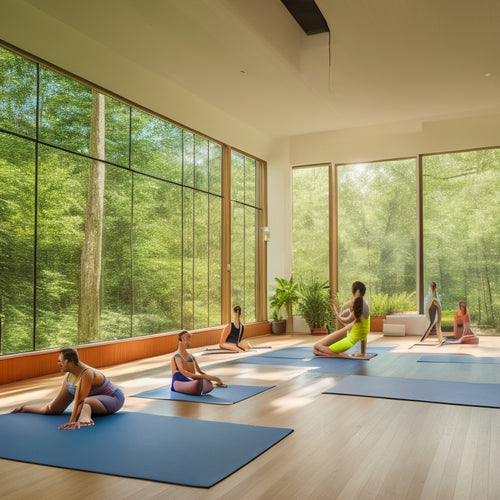
How High Should a Ballet Barre Be for Adults?
Share
When setting up a ballet barre for adults, the ideal height is one that finds a balance between comfort and efficiency, allowing you to maintain proper posture, freedom of movement, and focus on technique. Considering your body proportions, arm length, and flexibility will help you determine the perfect height. For most adults, the barre should be around waist-high, with your forearm parallel to the floor when you stand with your feet shoulder-width apart. Experiment with different heights to find your sweet spot, and as you fine-tune your setup, you'll discover even more nuanced adjustments to enhance your dance experience.
Key Takeaways
• Ideal barre height allows for freedom of movement and focus on technique, considering body proportions, dance style, and adjustability.
• Average heights for adult dancers range from 5'2" to 5'8", with 5'5" for females and 5'9" for males being the averages.
• Arm length determines ideal barre height, with adjustments needed for varying arm spans and hand shapes.
• Stand with feet shoulder-width apart and align the barre to forearm parallel to the floor for initial adjustment.
• Regular maintenance of barre height is necessary for a comfortable and safe studio setup.
Determining Ideal Barre Height
When setting up your ballet barre, the first question you should ask yourself is: what's the ideal barre height for your body, and how do you determine it? The answer lies in finding a balance between comfort and efficiency.
A barre that's too low can strain your back, while one that's too high can put unnecessary pressure on your shoulders. To find your ideal height, consider your body proportions and dance style. For instance, if you're a taller adult, you may prefer a higher barre to maintain proper posture.
Barre Innovation has led to the development of adjustable barres, allowing for greater Studio Efficiency. By finding your ideal barre height, you'll be able to move freely and focus on perfecting your technique.
Measuring for Comfort and Control
As you stand in front of the barre, you'll want to measure for comfort and control by considering two key points: the barre height options that suit your needs, and the proper posture alignment that will help you maintain balance and stability.
You'll need to find a height that allows you to stand comfortably with your arm relaxed and your elbow slightly bent. By getting these two factors just right, you'll be able to focus on your movements and execute them with precision and control.
Barre Height Options
To find your ideal barre height, measure the distance from the floor to the crease behind your wrist when your arm is relaxed by your side. This will give you a comfortable range of motion and help you maintain control during exercises.
This measurement will serve as a guideline for selecting a barre that suits your needs. Consider adjustable barres or those made from durable materials like wood or metal, which can withstand frequent use.
When setting up your home studio or deciding on a studio layout, make sure your barre is positioned to allow for easy movement and rotation. A well-placed barre will enable you to focus on your technique, promoting freedom of movement and expression.
Proper Posture Alignment
You'll want to stand tall with your feet shoulder-width apart, engaging your core and maintaining a neutral spine, as a properly aligned posture is crucial to achieving comfort and control at the barre. This allows you to move freely and efficiently, without putting unnecessary strain on your body.
To guarantee proper alignment, focus on:
- Engaging your core muscles to support your lower back
- Maintaining a neutral spine, avoiding arching or rounding
- Keeping your shoulders relaxed and down, avoiding scrunching
- Extending your spine, feeling a sense of length and openness
Factors Affecting Barre Height Needs
When determining the ideal ballet barre height for yourself, you'll need to take into account several factors that affect your needs.
Your body type plays a significant role - if you have a longer or shorter torso, your barre height requirements will differ.
As you'll discover, age and flexibility also come into play, influencing the perfect barre height to guarantee comfort and control.
Body Type Variations
Your body type greatly influences the ideal ballet barre height, as differences in body proportions and muscle structure can affect your posture, alignment, and overall comfort during exercises.
As you prepare for ballet exercises, consider how your body type impacts your needs.
-
If you have a muscular build, you may need a higher barre to accommodate your strength and muscle imbalance.
-
Those with longer legs or a larger torso may require a taller barre to maintain proper alignment.
-
Conversely, individuals with shorter legs or a smaller frame may prefer a lower barre for comfort.
- Lastly, those with body proportions that are more athletic or curvy may need a barre that caters to their unique muscle structure and flexibility.
Age and Flexibility
As you consider your body type's impact on ideal ballet barre height, it's equally important to factor in your age and flexibility, as these elements can greatly influence your barre height needs.
As you age, your flexibility naturally declines, making it more challenging to perform certain movements. This flexibility decline can lead to age-related injuries if you're not mindful of your barre height. For instance, if you're in your 30s or 40s, you may need a slightly lower barre to accommodate reduced flexibility in your hips and knees.
Average Heights for Adult Dancers
As an adult dancer, you're likely curious about the average heights of your peers. Adult dancers typically range in height from 5'2' to 5'8', with the average height for female dancers being around 5'5' and for male dancers around 5'9'.
This range is important to take into account when choosing a ballet barre, as it affects your body proportions and dance experience.
Here are some key factors to bear in mind:
- Your height affects your center of gravity and balance.
- A barre that's too high or low can throw off your alignment.
- Your dance experience will influence your comfort level with different barre heights.
- Proper barre height helps prevent injuries and improves technique.
Considering Arm Length and Reach
When selecting a ballet barre, your arm length and reach play a pivotal role in determining the ideal height, as a barre that's either too high or too low can force you to compromise your posture and alignment. Considering your arm span variations, you'll want to adjust the barre height accordingly. For instance, if you have shorter arms, a lower barre might be more suitable. On the other hand, if you have longer arms, a higher barre could be more comfortable.
| Hand Shape | Arm Length | Ideal Barre Height |
|---|---|---|
| Small hands | Short arms | 30-32 inches |
| Medium hands | Average arms | 32-34 inches |
| Large hands | Long arms | 34-36 inches |
Adjusting for Posture and Alignment
You'll need to adjust the barre height further based on your individual posture and alignment, as even a slight deviation from ideal posture can put unnecessary strain on your muscles and joints.
To promote excellent alignment, consider the following factors:
-
Core engagement: Make sure you're engaging your core muscles to support your posture, which will help you maintain a neutral spine and reduce strain on your lower back.
-
Spinal flexibility: Take into account your individual spinal flexibility, as this will affect how you align your body with the barre.
-
Shoulder alignment: Pay attention to your shoulder alignment, ensuring they're relaxed and down, avoiding any scrunching or tension.
- Pelvic alignment: Adjust the barre height to accommodate your natural pelvic tilt, ensuring your hips and lower back remain in alignment.
Barre Height for Different Exercises
Adjusting the barre height according to the specific exercise you're performing is essential to optimize your form and prevent discomfort or injury, so make sure to tailor it accordingly.
For example, when performing exercises that focus on leg swings or dégagés, you'll want the barre to be slightly lower to allow for a fuller range of motion.
Conversely, for exercises that involve intricate footwork or petit allegro, you may prefer a higher barre to support your movements.
Consider barre variations and exercise modifications to accommodate your needs. By adjusting the height, you'll be able to execute movements with precision and control, ensuring a more effective and enjoyable workout.
Customizing for Personal Comfort
To guarantee a comfortable and effective workout, start by setting the barre at a height that allows you to stand with your arm relaxed by your side, with a slight bend in your elbow. This will help you maintain good posture and avoid straining your shoulders or back.
To further customize the barre to your personal comfort, consider the following:
-
Make sure you have enough personal space around you to move freely without feeling cramped or restricted.
-
Adjust the barre to a height that allows you to stay within your comfort zone, neither too stretched nor too bent.
-
Experiment with different grip widths to find what feels most comfortable for your hands and wrists.
- Don't be afraid to take breaks or modify exercises that cause discomfort or pain – your body will thank you!
Tips for Barre Height Adjustment
When setting the barre to the ideal height, start by standing with your feet shoulder-width apart and your arms relaxed by your sides. Adjust the barre up or down to a point where your forearm is parallel to the floor. As you adjust, keep in mind that the barre should be at a height that allows you to maintain good posture without straining.
For best comfort, make sure your elbow is at a 90-degree angle and your wrist is straight. Regular barre maintenance is key to ensuring a comfortable and safe studio setup.
Frequently Asked Questions
Can I Use a Ballet Barre That's Adjustable in Height?
You can definitely use an adjustable ballet barre, enjoying the portability benefits and space-saving design that lets you practice anywhere, anytime, while easily accommodating different users and exercises.
How Often Should I Adjust My Ballet Barre's Height?
You'll want to adjust your ballet barre's height regularly, as you'll find that personal flexibility fluctuates; prioritize barre maintenance by tuning in to your body's needs, adjusting the height every 2-3 classes to guarantee ideal support.
Can I Use a Ballet Barre That's Too High or Too Low?
You'll struggle with Barre Struggles if your barre is too high or low, compromising Ideal Placement and proper alignment, so it's essential to find the sweet spot that allows you to move freely and comfortably.
Will a Taller Ballet Barre Help Me With My Posture?
When using a taller ballet barre, you'll maintain better spinal alignment and engage your core, promoting a longer, stronger you, as you work to improve your posture and overall dance form with increased confidence.
Can I Share a Ballet Barre With Someone of a Different Height?
'Did you know 75% of dancers prefer practicing with a partner? Sharing a ballet barre with someone of a different height can be tricky, but it's achievable. Height differences can cause sizing issues, so consider partner preferences and adjust the barre or use blocks to guarantee a comfortable fit.'
Related Posts
-

3 Essential Tools for Dance Makeup Artists Online
As a dance makeup artist, you already possess the skills to create stunning looks, and with the right digital tools, ...
-

5 Time-Saving Hacks for Busy Makeup Artists
You're a busy makeup artist juggling multiple tasks, from client appointments to kit maintenance and continuous skill...
-

Essential Spandex Shorts for Yoga and Pilates
Essential spandex shorts are vital for your yoga and Pilates practice. Look for moisture-wicking technology to keep y...


